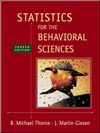 |  Statistics for the Behavioral Sciences, 4/e Michael Thorne,
Mississippi State University -- Mississippi State
Martin Giesen,
Mississippi State University -- Mississippi State
Probability
Problems- You’ve flipped a coin 9 times, and it has come up heads each time. There’s no reason to believe the
coin is biased. Do you think it’s more or less likely that the next flip will produce another head? What
is the probability of another head on the 10th flip?
- Suppose you draw a single card from a standard 52-card deck. What is the probability of drawing the
following cards?
- the ace of hearts
- an ace
- a face card (jack through ace)
- a heart
- a card that is not a heart
- In a sock drawer, there are 6 brown socks, 12 blue socks, 4 red socks, and 8 green socks randomly
mixed together. With your eyes shut, you take a single sock from the drawer. What is the probability of
getting the following socks?
- a brown sock
- a blue sock
- a yellow sock
- a sock that is not red
- a red or a green sock
- a sock that is neither blue nor green
- Suppose you answer a single question on a true–false test purely by chance.
- What is the probability that you will miss it?
- What is the probability that you’ll get it right?
- Suppose you have a multiple-choice question with four choices.
- What is the probability of guessing correctly?
- What is the probability of an incorrect guess?
- In terms of probability, which is easier, a multiple-choice question or a true–false question?
- A slot machine has three identical reels with 10 different symbols on each reel. You pull the lever, and
the reels spin independently until they stop. Assuming the symbols include stars, whistles, and clowns,
what is the probability of getting the following?
- three stars
- two stars and a whistle
- a star, a whistle, and a clown
- the same three of any of the 10 symbols.
- A box contains six pieces of currency: three $1 bills, two $5 bills, and one $20 bill. You can remove
only one bill at a time. On two successive draws, with replacement, what is the probability of getting
the following?
- the $20 bill twice
- two $1 bills
- two $5 bills
- a $1 bill and the $20 bill, in that order
- $21 for the sum of the two bills
- $6 for the sum of the two bills
- Consider again the box from Problem 7. On two successive draws, without replacement, what is the
probability of getting the following?
- $40
- $25
- $2
- $6
- The psychology club conducted a lottery and sold 150 tickets. You bought 1 ticket, and your friend
bought 3 tickets. There will be a first-place winner and a second-place winner.
- What is the probability that you will win first place?
- What is the probability that you will win first or second place?
- What is the probability that you or your friend will win first place?
- What is the probability that you or your friend will win something (either first or second place)?
- What is the probability that both you and your friend will win something?
- Suppose you obtain a biased coin with p(head) = .6 and p(tail) = .4. What is the probability of three
heads in five flips? Of four heads in five flips?
- A study was made of the relationship between personality type (extraversion/introversion) and whether
a student held an office in a club or student organization. The results are summarized in the following
table of probabilities:
| | Personality Type | | Held Office | | | Extravert | Introvert | Total | | Yes | .28 | .10 | .38 | | No | .24 | .38 | .62 | | Total | .52 | .48 | 1.00 |
|
- What is the probability that a student will hold some office?
- What is the probability that, given the student is an extravert, he or she will hold some office?
- Does the added information about personality aid in predicting whether the student holds office?
- Is personality type extravert or introvert (E–I) independent of holding office? Explain.
 Click here to view the answers (7.0K) Click here to view the answers (7.0K) |
|



 2003 McGraw-Hill Higher Education
2003 McGraw-Hill Higher Education